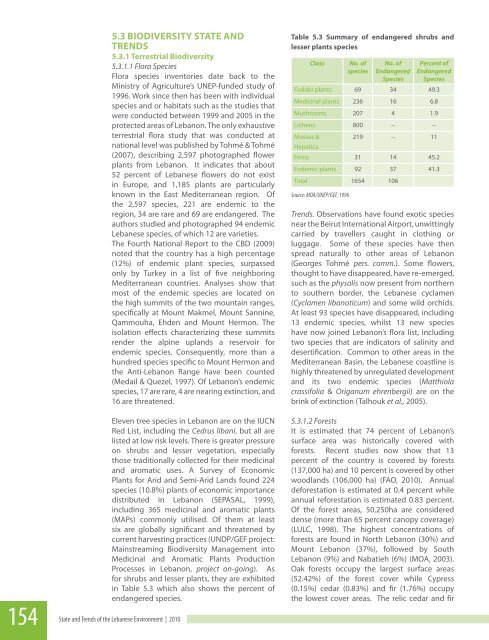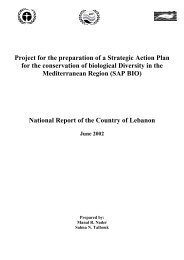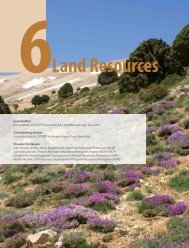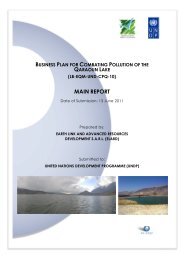Biodiversity and Forests
Biodiversity and Forests
Biodiversity and Forests
You also want an ePaper? Increase the reach of your titles
YUMPU automatically turns print PDFs into web optimized ePapers that Google loves.
154<br />
5.3 BIODIVERSITY STATE AND<br />
TRENDS<br />
5.3.1 Terrestrial <strong>Biodiversity</strong><br />
5.3.1.1 Flora Species<br />
Flora species inventories date back to the<br />
Ministry of Agriculture’s UNEP-funded study of<br />
1996. Work since then has been with individual<br />
species <strong>and</strong> or habitats such as the studies that<br />
were conducted between 1999 <strong>and</strong> 2005 in the<br />
protected areas of Lebanon. The only exhaustive<br />
terrestrial flora study that was conducted at<br />
national level was published by Tohmé & Tohmé<br />
(2007), describing 2,597 photographed flower<br />
plants from Lebanon. It indicates that about<br />
52 percent of Lebanese flowers do not exist<br />
in Europe, <strong>and</strong> 1,185 plants are particularly<br />
known in the East Mediterranean region. Of<br />
the 2,597 species, 221 are endemic to the<br />
region, 34 are rare <strong>and</strong> 69 are endangered. The<br />
authors studied <strong>and</strong> photographed 94 endemic<br />
Lebanese species, of which 12 are varieties.<br />
The Fourth National Report to the CBD (2009)<br />
noted that the country has a high percentage<br />
(12%) of endemic plant species, surpassed<br />
only by Turkey in a list of five neighboring<br />
Mediterranean countries. Analyses show that<br />
most of the endemic species are located on<br />
the high summits of the two mountain ranges,<br />
specifically at Mount Makmel, Mount Sannine,<br />
Qammouha, Ehden <strong>and</strong> Mount Hermon. The<br />
isolation effects characterizing these summits<br />
render the alpine upl<strong>and</strong>s a reservoir for<br />
endemic species. Consequently, more than a<br />
hundred species specific to Mount Hermon <strong>and</strong><br />
the Anti-Lebanon Range have been counted<br />
(Medail & Quezel, 1997). Of Lebanon’s endemic<br />
species, 17 are rare, 4 are nearing extinction, <strong>and</strong><br />
16 are threatened.<br />
Eleven tree species in Lebanon are on the IUCN<br />
Red List, including the Cedrus libani, but all are<br />
listed at low risk levels. There is greater pressure<br />
on shrubs <strong>and</strong> lesser vegetation, especially<br />
those traditionally collected for their medicinal<br />
<strong>and</strong> aromatic uses. A Survey of Economic<br />
Plants for Arid <strong>and</strong> Semi-Arid L<strong>and</strong>s found 224<br />
species (10.8%) plants of economic importance<br />
distributed in Lebanon (SEPASAL, 1999),<br />
including 365 medicinal <strong>and</strong> aromatic plants<br />
(MAPs) commonly utilised. Of them at least<br />
six are globally significant <strong>and</strong> threatened by<br />
current harvesting practices (UNDP/GEF project:<br />
Mainstreaming <strong>Biodiversity</strong> Management into<br />
Medicinal <strong>and</strong> Aromatic Plants Production<br />
Processes in Lebanon, project on-going). As<br />
for shrubs <strong>and</strong> lesser plants, they are exhibited<br />
in Table 5.3 which also shows the percent of<br />
endangered species.<br />
State <strong>and</strong> Trends of the Lebanese Environment | 2010<br />
Table 5.3 Summary of endangered shrubs <strong>and</strong><br />
lesser plants species<br />
Class No. of<br />
species<br />
No. of<br />
Endangered<br />
Species<br />
Percent of<br />
Endangered<br />
Species<br />
Fodder plants 69 34 49.3<br />
Medicinal plants 236 16 6.8<br />
Mushrooms 207 4 1.9<br />
Lichens 800 -- --<br />
Mosses &<br />
Hepatica<br />
219 -- 11<br />
Ferns 31 14 45.2<br />
Endemic plants 92 37 41.3<br />
Total 1654 106<br />
Source: MOA/UNEP/GEF, 1996<br />
Trends. Observations have found exotic species<br />
near the Beirut International Airport, unwittingly<br />
carried by travellers caught in clothing or<br />
luggage. Some of these species have then<br />
spread naturally to other areas of Lebanon<br />
(Georges Tohmé pers. comm.). Some flowers,<br />
thought to have disappeared, have re-emerged,<br />
such as the physalis now present from northern<br />
to southern border, the Lebanese cyclamen<br />
(Cyclamen libanoticum) <strong>and</strong> some wild orchids.<br />
At least 93 species have disappeared, including<br />
13 endemic species, whilst 13 new species<br />
have now joined Lebanon’s flora list, including<br />
two species that are indicators of salinity <strong>and</strong><br />
desertification. Common to other areas in the<br />
Mediterranean Basin, the Lebanese coastline is<br />
highly threatened by unregulated development<br />
<strong>and</strong> its two endemic species (Matthiola<br />
crassifolia & Origanum ehrenbergii) are on the<br />
brink of extinction (Talhouk et al., 2005).<br />
5.3.1.2 <strong>Forests</strong><br />
It is estimated that 74 percent of Lebanon’s<br />
surface area was historically covered with<br />
forests. Recent studies now show that 13<br />
percent of the country is covered by forests<br />
(137,000 ha) <strong>and</strong> 10 percent is covered by other<br />
woodl<strong>and</strong>s (106,000 ha) (FAO, 2010). Annual<br />
deforestation is estimated at 0.4 percent while<br />
annual reforestation is estimated 0.83 percent.<br />
Of the forest areas, 50,250ha are considered<br />
dense (more than 65 percent canopy coverage)<br />
(LULC, 1998). The highest concentrations of<br />
forests are found in North Lebanon (30%) <strong>and</strong><br />
Mount Lebanon (37%), followed by South<br />
Lebanon (9%) <strong>and</strong> Nabatieh (6%) (MOA, 2003).<br />
Oak forests occupy the largest surface areas<br />
(52.42%) of the forest cover while Cypress<br />
(0.15%) cedar (0.83%) <strong>and</strong> fir (1.76%) occupy<br />
the lowest cover areas. The relic cedar <strong>and</strong> fir





